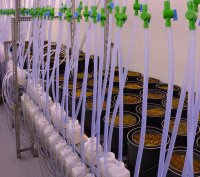
Peat mosses or sphagnum, the main plant in the northern peatlands, are highly dependent on the availability of water, especially in the top layer, which is 5-10 centimetres thick. Nijp and his colleagues put this to the test by exposing different kinds of sphagnum to different rainfall patterns at different groundwater levels in a climate chamber. The total volume of rain per test did not vary, but the interval between showers and the volume per shower did. The results varied. Some species of sphagnum grow better if it rains more frequently; for others it is the other way round. In the climate chamber, that is.
But these kinds of processes are usually ignored in large-scale climate models.
Jelmer Nijp
To find out how this works outside in the field, Nijp compared 11 years’ worth of CO2 data on peatland in Sweden with the meteorological records. What emerged was quite the opposite: the more often it rained, the less CO2 the peatland absorbed. ‘In view of our experiment that was quite unexpected,’ says Nijp. But an explanation was soon found. ‘Clouds during a shower reduce the amount of light so much that the absorption of CO2 by the sphagnum goes down. Light has a greater effect on CO2 absorption than the soaking caused by rain.’
According to Nijp, showers reduce carbon absorption by sphagnum by one quarter. Drought on the other hand appears at first sight to be a less pressing problem. The peatland protects itself against drought by shrinking, ‘pretty much like a sponge’. When groundwater levels fall, the peat shrinks, and vice versa. Nijp: ‘Swelling and shrinking stabilizes the moisture balance of sphagnum. In these kinds of peatland systems, that can make a difference of up to eight centimetres.’ This makes peatland more resilient in the face of climate change than has been assumed.
Nijp calculated the effects of rain and drought at micro level using a simulation model. The result is encouraging. Small-scale processes which regulate moisture for sphagnum play a key role in CO2 storage. But these kinds of processes are usually ignored in large-scale climate models. And wrongly so.’
